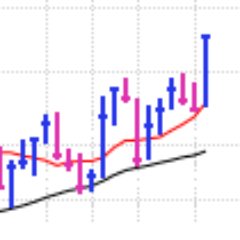My advice if you're on the verge of giving up due to lack of profit momentum or constantly missing trades over years in this pursuit: 1) Analyze Your Trade History: Review your trade journal and break down the average avg profit/avg loss across different strategies you've used. Win rate % analysis can only happen if you have proper non-discretionary profit/loss rules for every single trade. Avg profit/Avg loss factor of a strategy equate to robustness, but not edge. 2) Focus on that One Strategy: For the next six months, strictly focus on the one strategy with the highest average profit/avg loss ratio. 3) Refine Your Routine: Review your current routine and tailor a pre-market and post-market process centered around that strategy. It should align with your lifestyle with minimal disruption. For day traders, this often requires more sacrifice compared to swing or mid-term traders. When we talk about sustainable routine, we are talking about turning up daily in both good and bad days. 4) Reevaluate Your Screening Criteria: Your screen should identify potential trades before they move, not after. Executing trades based on follow-through from the prior day often distorts the trade's risk-reward ratio because you have a missed the most optimal entry, stop level and size. You may already be a profitable trader if you execute trades 1 day ahead of your actual execution. Only enter trade at the most optimal entry, if not it is perfectly to miss it than to lose money over it. 5) Create a Non-Discretionary Profit and Stop-Loss Plan: Establish clear rules for taking profits and setting stop-losses without relying on intuition. We often misjudge and struggle to hold onto trades that could make a significant difference. The biggest winning trade are often those that you can sit on the longest. 6) Review and Grade Trades: After 3 months, categorize your trades as 'A', 'B', or 'C' rated based on setup and execution quality. The more you review your trades, the better you'll understand where to refine your selection criteria, execution, and trade management. Also, track monthly metrics like trade frequency, average holding period for winners vs. losers, win rate, profit factor, and average percentage gain/loss. Even if you're not yet profitable, seeing month-over-month improvement in these numbers builds confidence and anticipation for each market day. Some traders dread the market open because of the lack of confidence and this stern from them not knowing where they are in terms of mathematical statistics of their own trading. 7) Continue Learning: If you can set aside time for growth, I highly recommend reading *Phantom of the Pit*. It's a free and underrated yet powerful trading book that you can finish in about four hours. It had an immediate impact on me, and I wish I had read it in my initial years. x.com/jfsrevg/status… 8) Refine, Enhance, and Repeat: As you approach the 3rd month, continue refining steps 3, 4, 5, and 6, and carry this process into month 6th. I highly encourage quarterly (at minimum) review of MoM trade journal to gauge improvement and establish refinement. Improving your trading performance often comes from reviewing your own trading history, unlearning unhelpful 'principles' that is unknowingly eroding your performance, and focusing on simple principles in your own strategy that can truly lead to growth. Give yourself time and the discipline to stick with the process. Good trading can be boring, but it can provide a solid living in time to come. You can trust me on this.
My advice if you're on the verge of giving up due to lack of profit momentum or constantly missing trades over years in this pursuit: 1) Analyze Your Trade History: Review your trade journal and break down the average avg profit/avg loss across different strategies you've used. Win rate % analysis can only happen if you have proper non-discretionary profit/loss rules for every single trade. Avg profit/Avg loss factor of a strategy equate to robustness, but not edge. 2) Focus on that One Strategy: For the next six months, strictly focus on the one strategy with the highest average profit/avg loss ratio. 3) Refine Your Routine: Review your current routine and tailor a pre-market and post-market process centered around that strategy. It should align with your lifestyle with minimal disruption. For day traders, this often requires more sacrifice compared to swing or mid-term traders. When we talk about sustainable routine, we are talking about turning up daily in both good and bad days. 4) Reevaluate Your Screening Criteria: Your screen should identify potential trades before they move, not after. Executing trades based on follow-through from the prior day often distorts the trade's risk-reward ratio because you have a missed the most optimal entry, stop level and size. You may already be a profitable trader if you execute trades 1 day ahead of your actual execution. Only enter trade at the most optimal entry, if not it is perfectly to miss it than to lose money over it. 5) Create a Non-Discretionary Profit and Stop-Loss Plan: Establish clear rules for taking profits and setting stop-losses without relying on intuition. We often misjudge and struggle to hold onto trades that could make a significant difference. The biggest winning trade are often those that you can sit on the longest. 6) Review and Grade Trades: After 3 months, categorize your trades as 'A', 'B', or 'C' rated based on setup and execution quality. The more you review your trades, the better you'll understand where to refine your selection criteria, execution, and trade management. Also, track monthly metrics like trade frequency, average holding period for winners vs. losers, win rate, profit factor, and average percentage gain/loss. Even if you're not yet profitable, seeing month-over-month improvement in these numbers builds confidence and anticipation for each market day. Some traders dread the market open because of the lack of confidence and this stern from them not knowing where they are in terms of mathematical statistics of their own trading. 7) Continue Learning: If you can set aside time for growth, I highly recommend reading *Phantom of the Pit*. It's a free and underrated yet powerful trading book that you can finish in about four hours. It had an immediate impact on me, and I wish I had read it in my initial years. x.com/jfsrevg/status… 8) Refine, Enhance, and Repeat: As you approach the 3rd month, continue refining steps 3, 4, 5, and 6, and carry this process into month 6th. I highly encourage quarterly (at minimum) review of MoM trade journal to gauge improvement and establish refinement. Improving your trading performance often comes from reviewing your own trading history, unlearning unhelpful 'principles' that is unknowingly eroding your performance, and focusing on simple principles in your own strategy that can truly lead to growth. Give yourself time and the discipline to stick with the process. Good trading can be boring, but it can provide a solid living in time to come. You can trust me on this.
@jfsrevg so much value in this post Jeff. Thanks for taking the time 🙏
@jfsrevg Hi Jeff Just want to say thank you for this post and all the others. You have an ability to distill key detail in clearly understandable written word. Can only come from someone who has walked the road himself. Best wishes
@jfsrevg Jeff I have learned so much from you. Thank you for sharing all of your tips and advice. It’s really priceless. Just know so many folks appreciate your efforts. We know you don’t have to thanks for paying it forward. Please reach out if ever near nyc would love to grab a beer.
Hi Jeff, how would you advice on these following issues - either I'm entering too early (like $TCOM), spending time on stocks that consolidate but don't move (like $VOXX) or I'm exiting myself way too soon (like $OKLO)? I reviewed $TCOM but do realise I was too defensive. For $OKLO, I can't seem to find any reason why I should have stayed after weak candle formations over 6 days. For $VOXX, no idea why it just doesn't move nor can i find a reason how to avoid a similar situation. Any advice is appreciated, thank you!
@jfsrev My advice if you are on the verge of giving up because you haven't made money in this bull market...yeah you should probably just give up. It doesn't get easier than this.
@jfsrevg Great advice. You’re one of the best follows on this platform. 👍
@jfsrev I didn’t get anywhere until I focused on one strategy, and actually picked it apart. Only then could I move on to a second (I currently have 3).
@jfsrevg i'd add in this.. 1) journaling is key.. not just trades.. anything on your mind. actually creative writing has an exercise called "morning pages" where you simply write whatever is on your mind. 2) Shadow a trader. copy them to learn a style. this is called "modeling"
@jfsrevg you inspired me to start journalling in discord and analysing myself and my trades. im currently working on not giving back open profits on positions.
@jfsrevg probably your post was bookmarked 500 times but maybe 50 of them actually took the time to read it thats problem with these traders
@jfsrevg I hate reviewing past trades but you see the mistake very clearly when you do. I need to do it more often. I’ll work on it today. I really hate doing it.
@jfsrevg (1/2)Hi Jeff, my question isn't directly relevant to this post. Every time I wait for volume confirmation to enter a trade, I usually miss it because I have a full-time job and can't monitor the market continuously.
@jfsrevg Hi Jeff , always pleasure to read your posts✌️. If you can anytime explain whats your strategy for tackling opposite gap ups/downs ?














